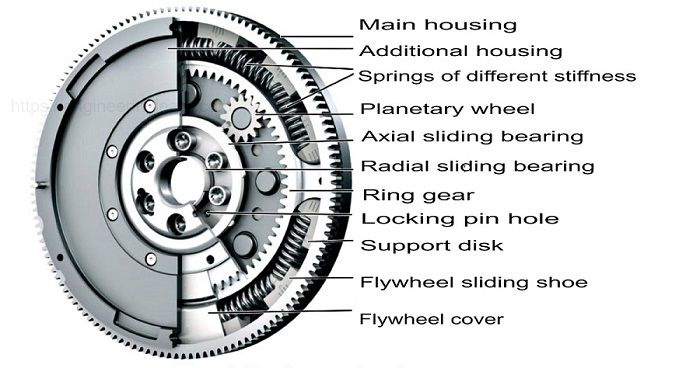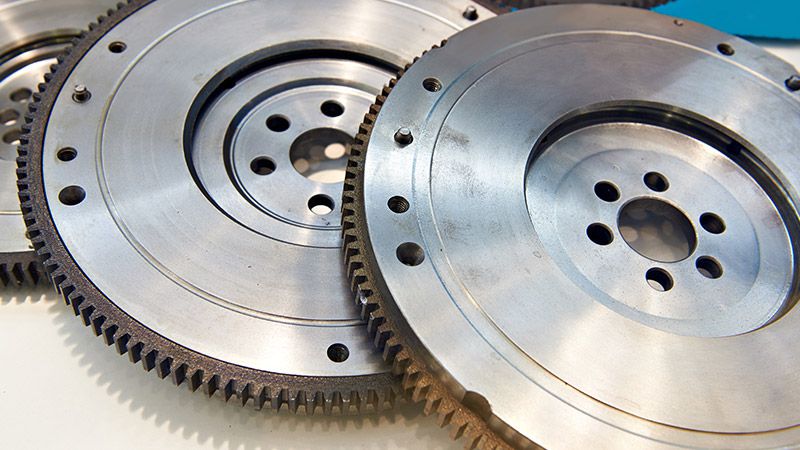A flywheel is a mechanical device that uses conservation of angular momentum to store rotational energy; a form of kinetic energy that is proportional to the product of its moment of inertia and the square of its rotational speed.
A flywheel is a heavy wheel attached to a rotating shaft to smooth the transfer of power from an engine to a machine. In automobile engines, the flywheel serves to smooth out the pulses of energy provided by combustion in the cylinders and provide energy for the compression stroke of the pistons.
The inertia of the flywheel opposes and moderate engine speed fluctuations and stores the excess energy for intermittent use. In order to effectively counteract speed fluctuations, a flywheel is given a high rotational inertia; i.e., most of its weight is far from the axis.
However, the energy stored in a flywheel depends on both weight distribution and speed; if the speed is doubled, the kinetic energy is quadrupled. A rim-type flywheel will burst at a much lower RPM than a disc wheel of the same weight and diameter.
For minimal weight and high energy storage capacity, a flywheel can be fabricated from high-strength steel and designed as a conical disc, thick in the center and thin around the rim.
In automobile engines, the flywheel serves to smooth out the pulses of energy provided by combustion in the cylinders and provide energy for the compression stroke of the pistons. The larger the rotational inertia of the flywheel, the smaller the changes in speed resulting from the intermittent power supply and demand.
What Is The Use Of A Flywheel?
Common uses of a flywheel are:
- Smoothing the power output of an energy source. Flywheels are used in reciprocating engines, for example, because the active torque of the individual pistons is intermittent.
- Energy storage systems
- Delivery of energy at rates that are beyond the capabilities of an energy source. It does this by collecting energy in a flywheel over time and then rapidly releasing it at rates that are beyond the capabilities of the energy source.
- Control the alignment of a mechanical system, gyroscope and reaction wheel
Flywheels are typically made of steel and rotate on conventional bearings; these are usually limited to a maximum speed of a few thousand rpm. High energy density flywheels can be made from carbon fiber composites and use magnetic bearings, which allows them to rotate at speeds of up to 60,000 rpm (1 kHz).
Parts Of Flywheel
Following are the parts of a flywheel:

- Flywheel Housing: The flywheel housing is solid and sits outside the flywheel. The flywheel is the part of the engine that turns and supplies power to the alternator.
- Springs: The flywheel consists of two-phase springs bent in parallel. The outer arc is adjusted to raise the spring when the engine is running. The soft outer bow spring is only used to improve the unsafe resonance frequency range.
- Planet Wheel: A planet wheel consists of many planet gears that are attached to a flywheel holder. When the flywheel mount is screw actuated and rotates, engagement with the outer ring gear creates a compound motion made up of each planet gear revolution and rotation.
- Axial and radial plain bearings: While the axially acting bearing only serves to balance the weight, the imbalances or parasitic radial forces introduced by the motor or generator unit must be compensated by radial bearings.
- Ring gear: A ring gear is attached to the outside diameter of the flywheel. The fixation on the flywheel is usually done with the help of a interference fit, which is created by heating the ring gear. So the thermal expansion allows it to be placed around the flywheel.
- Support Disc: As the name suggests, the support disc is placed in the flywheel to support the two-phase bent springs and other components of the flywheel.
- Flywheel sliding shoe: sliding shoes preferably have a convex, radial outer area which rests against the inner wall of the flywheel. In this area, they are preferably made to be slip-promoting and wear-resistant.
- Flywheel Cover: The flywheel cover is usually made of chrome. This chrome-plated flywheel cover prevents dust from getting into the internal functions of the flywheel, causing it to run poorly.
Function Of Flywheel
Flywheels are found in almost all types of automobiles because they serve a variety of purposes, which are discussed here. The following are the functions of the flywheel in a car engine:
Balancing the engine: because the pistons are offset from the center of the crankshaft oscillation and wobble occurs. This is also because each piston fires at a different angle.
The function of a flywheel in this situation is to suppress the sideways movement. This is achieved by the heavyweight of the flywheel. Flywheels reduce the vibration of the engine as a whole as the engine is stabilized and balanced on the bearings.
Starting the engine: The flywheel plays an additional role in starting the engine. The teeth of the flywheel are attached to a starter motor. This starter is controlled with the car key so that when the vehicle is started, the starter turns the flywheel.
As soon as the engine turns, the combustion effect keeps turning the engine. The Bendix gearbox in the started motor will retract to allow the flywheel to rotate freely.
Reducing the load on the drive train: is another function of a flywheel, which is achieved by stabilizing the movement of the engine. It also smoothes the engine speed and reduces wear on the drive components.
The flywheel also limits wear between the transmission shaft and the drive shaft. These two are attached with a universal joint.
Speed-reducing: The crankshaft converts the piston movement into a jerky rotary movement when the force is generated. the speed of the crankshaft is constant and the engine runs smoothly. This is because the mass of the flywheel creates inertia that kept the engine crankshaft rotating between each piston firing.
Weight manipulation: The weight of a flywheel determines the performance of an engine. The weight depends on the performance of the vehicles.
Heavier flywheels allow the engine to work under loads, which can cause the engine to stall. Large trucks or trailers work well with the heavier flywheels, while sports cars and some commercial vehicles make good use of the lighter flywheels.
How Does A Flywheel Work?
A flywheel is essentially a mechanical battery consisting of a mass rotating around an axis. It stores energy in the form of kinetic energy and works by accelerating a rotor to very high speeds and maintaining the energy in the system as rotational energy.
Well, you can compare it to the mechanism of a mechanical battery. Whereas the battery stores the energy in a chemical form, a flywheel preserves the power in the form of movement or kinetic energy to be precise.
A flywheel will be able to store more energy if it spins at a higher speed or has a higher moment of inertia, which means bulkier. However, it always works best when you spin it faster rather than increasing its mass.
For example, a wheel will produce twice as much energy than the one that weighs half of it, given that both are spun at the same speed. On the other hand, spinning the lighter wheel twice as fast will quadruple the amount of stored energy.
For this reason, it’s always better to use lighter, high-speed wheels rather than the units having a massive weight. Also, compact flywheels make practical sense in racing cars because they need to be as light as possible to run at high speeds.
Types Of Flywheel
Following are the types of flywheels used in vehicles:
- Solid disc flywheel
- Rimmed flywheel
- High-velocity flywheel
- Low-velocity flywheel
1. Solid Disc Flywheel
The solid disc flywheel is a type of flywheel. It is used in a single flywheel threshing machine that is made of cast iron. The full disc flywheel is equipped with a flywheel hub and disc.
When calculating the design of a full-disc flywheel, various parameters are used as inputs. This includes the dimensions of the full-disc flywheel. The resulting function values are also calculated.
2. Rimmed Flywheel
The rim-type flywheel explodes at a much slower speed than a full disc wheel of the same weight and diameter. For minimal weight and high energy storage capacity, a flywheel can be formed from high-strength steel and manufactured as a centrally thick conical disk.
3. High-Velocity Flywheel
In these types of flywheels, the high-speed flywheel has a speed between 30,000 rpm to 80,000 rpm. This can also be set up to 100,000 rpm.
They have magnetic levitation bearings and are low-maintenance. Compared to a slow-running flywheel, these are light depending on size/capacity. They are more expensive than a low-velocity flywheel.
4. Low-Velocity Flywheel
In these types of flywheels, the low-velocity flywheel has a speed of 10,000 rpm. They are heavier and bulkier than the high-velocity flywheels.
They require maintenance from time to time and do not use magnetic levitation bearings. Their installation requires a special concrete structure to support their weight. They are cheaper than high-speed flywheels.
Symptoms Of A Bad Flywheel
Unfortunately, flywheels do not last forever. They gradually become worn as they are consistently used in the vehicle. If your flywheel becomes too worn out or damaged, there will be some noticeable symptoms that you won’t be able to ignore.
Do not let these symptoms carry on for too long or else it will impact the overall drivability of the vehicle. Here are some of the most common signs of a bad flywheel.
1. Gears Slipping
Slipping gears more commonly occurs when you increase your gears. For example, you may go to put your car from second gear into third gear. As you shift gears, your engine revs and you can tell that it did not shift gears. Your car likely has slipped back to the gear you tried to advance from, or in this case, slipped back to second gear.
Unfortunately, slipping gears is also a tell-tale sign of clutch trouble. As such, if you experience slipping gears, you need to look for other signs so you can determine if the clutch or flywheel is going bad.
2. Burning Smell
If there is a burning smell that consumes your passenger cabin, this could be attributed to many possible causes. A bad flywheel could be one of those causes because of all the heat generated from the friction in the clutch.
If you have used the clutch at times when you weren’t supposed to, this could cause problems with the flywheel.
3. Clutch Chatter
If your clutch pedal is experiencing lots of vibrations, then your flywheel is likely going bad. The vibrations will eventually get so bad that you will be able to feel them on the floor rather than just from the clutch pedal.
As you drive your vehicle, the flywheel could end up with excessive runout over time, which leaves the surface feeling warped as you engage the clutch.
If you’ve ever overheated your flywheel or driven too long with a clutch that was on its last legs, it is very likely that you have damaged the flywheel due to excessive heat or metal on metal wear. Clutches that are worn down to the rivets will damage the flywheel.


